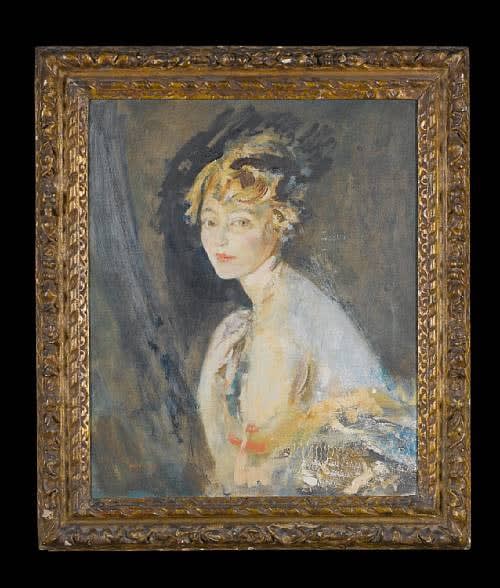
Ambrose McEvoy
Miss Helen Morris, a Study, 1918
Oil on canvas
30 x 25 in (76.5 x 63.5 cm)
Signed, lower left, ‘McEvoy’.
Philip Mould & Co.
To view all current artworks for sale visit philipmould.com This striking study, which at first looks almost contemporary in its vigorous use of colour and impasto, was painted in...
To view all current artworks for sale visit philipmould.com
This striking study, which at first looks almost contemporary in its vigorous use of colour and impasto, was painted in 1918. Ambrose McEvoy was one of the most adventurous British artists of the early twentieth century. He frequently experimented with composition and technique, and was one of the first artist’s to focus on mixing artificial and natural light in his portraits. As a result, the sitter here is brightly illuminated with a warm glow, and emerges forcefully out of the canvas. As with many of McEvoy’s portraits, the viewer’s attention is maintained by an unusual perspective or pose, thus enlivening an otherwise formal and static composition. As a display of McEvoy’s noted ability to combine both classical painting with modernism, we see here Miss Morris’ hand drawn in the manner of an old master.
McEvoy began his career at the Slade School of Fine Art, having been encouraged by, among others, James Abbott McNeill Whistler. His artistic friends included Augustus John, with whom he briefly lived, and in 1898 he became romantically involved with Gwen John. McEvoy first focused on genre painting, but after exhibiting a portrait of his wife, Mary, at the National Portrait Society in 1915, increasingly focused on portraiture. During the First World War, he was dispatched to the Western Front and to the North Sea fleet to record Victoria Cross winners and senior officers. These military portraits can be seen today at the Imperial War Museum. Amongst them are a moving series of highly decorated lower ranks, such as Petty Officer E Pitcher VC, who, despite their heroic actions, convey only a hollow sense of weariness.
This striking study, which at first looks almost contemporary in its vigorous use of colour and impasto, was painted in 1918. Ambrose McEvoy was one of the most adventurous British artists of the early twentieth century. He frequently experimented with composition and technique, and was one of the first artist’s to focus on mixing artificial and natural light in his portraits. As a result, the sitter here is brightly illuminated with a warm glow, and emerges forcefully out of the canvas. As with many of McEvoy’s portraits, the viewer’s attention is maintained by an unusual perspective or pose, thus enlivening an otherwise formal and static composition. As a display of McEvoy’s noted ability to combine both classical painting with modernism, we see here Miss Morris’ hand drawn in the manner of an old master.
McEvoy began his career at the Slade School of Fine Art, having been encouraged by, among others, James Abbott McNeill Whistler. His artistic friends included Augustus John, with whom he briefly lived, and in 1898 he became romantically involved with Gwen John. McEvoy first focused on genre painting, but after exhibiting a portrait of his wife, Mary, at the National Portrait Society in 1915, increasingly focused on portraiture. During the First World War, he was dispatched to the Western Front and to the North Sea fleet to record Victoria Cross winners and senior officers. These military portraits can be seen today at the Imperial War Museum. Amongst them are a moving series of highly decorated lower ranks, such as Petty Officer E Pitcher VC, who, despite their heroic actions, convey only a hollow sense of weariness.
Provenance
James Fergusson Esq.Anonymous sale; Christie's, London, 21 November 1969, lot 38.
Private Collection.
Literature
‘The Works of Ambrose McEvoy from 1900 to May 1919’ (London 1919), p.8Be the first to hear about our available artworks
* denotes required fields
We will process the personal data you have supplied in accordance with our privacy policy (available on request). You can unsubscribe or change your preferences at any time by clicking the link in our emails.